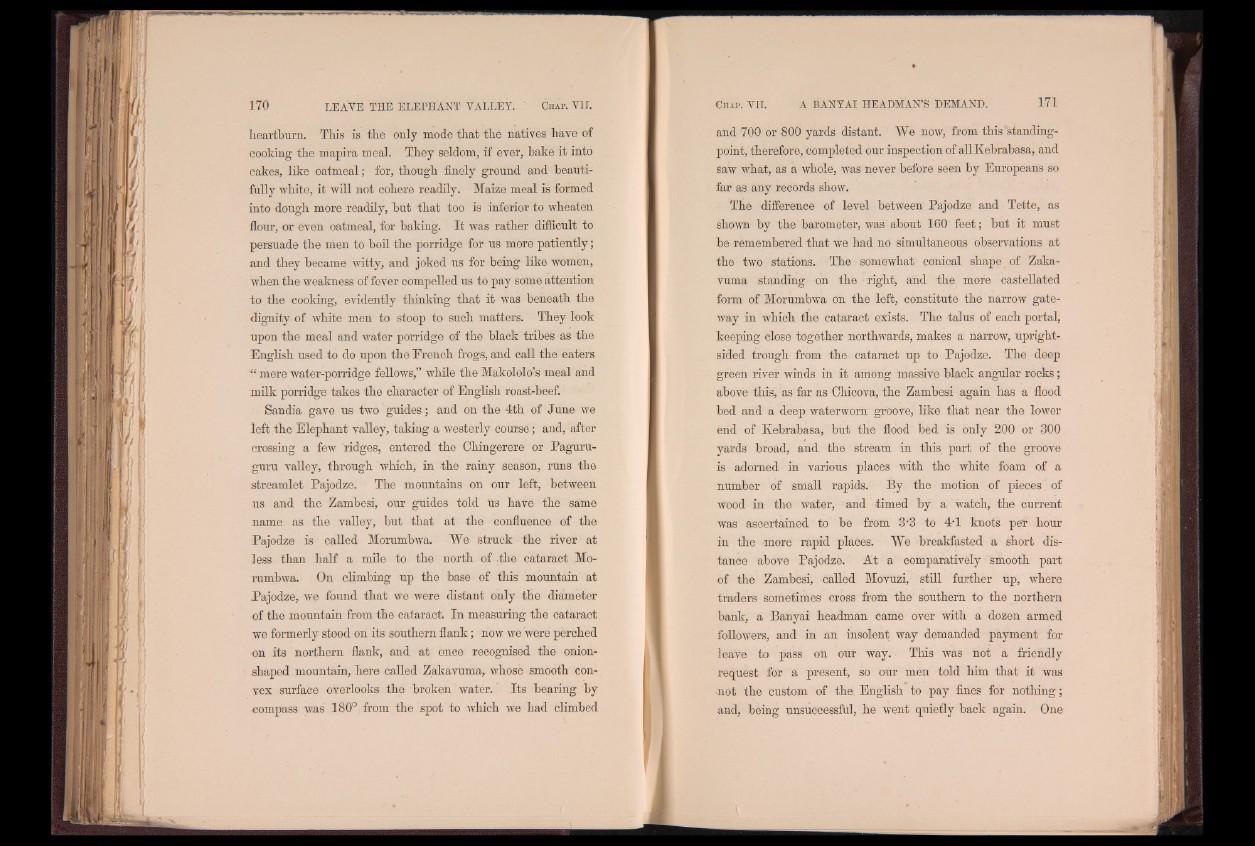
heartburn. This is the only mode that the natives have of
cooking the mapira meal. They seldom, if ever, bake it into
cakes, like oatmeal; for, though finely ground and beautifully
white, it will not cohere readily. Maize meal is formed
into dough more readily, but that too is inferior to wheaten
flour, or even oatmeal, for baking. It was rather difficult to
persuade the men to boil the porridge for us more patiently;
and they became witty, and joked us for being like women,
when the weakness of fever compelled us to pay some attention
to the cooking, evidently thinking that it was beneath the
dignity of white men to stoop to such matters. They look
upon the meal and water porridge of the black tribes as the
English used to do upon the Erench frogs, and call the eaters
■“ mere water-porridge fellows,” while the Makololo’s meal and
milk porridge takes the character of English roast-beef.
Sandia gave us two guides; and on the 4th of June we
left the Elephant valley, taking a westerly course; and, after
crossing a few ridges, entered the Chingerere or Paguru-
guru valley, through which, in the rainy season, runs the
streamlet Pajodze. The mountains on our left, between
us and the Zambesi, our guides told us have the same
name, as the valley, but that at the confluence of the
Pajodze is called Morumbwa. We struck the river at
less than half a mile to the north of the cataract Morumbwa.
On climbing up the base of this mountain at
Pajodze, we found that we were distant only the diameter
of the mountain from the cataract. In measuring the cataract
we formerly stood on its southern flank; now we were perched
on its northern flank, and at once recognised the onionshaped
mountain, here called Zakavuma, whose smooth convex
surface overlooks the broken water. Its bearing by
compass was 180° from the spot to which we had climbed
and 700 or 800 yards distant. We now, from this standing-
point, therefore, completed our inspection of allKebrabasa, and
saw what, as a whole, was never before seen by Europeans so
far as any records show.
The difference of level between Pajodze and Tette, as
shown by the barometer, was about 160 feet; but it must
be remembered that we had no simultaneous observations at
the two stations. The somewhat conical shape of Zakavuma
standing on the right, and the more castellated
form of Morumbwa on the left, constitute the narrow gateway
in which the cataract exists. The talus of each portal,
keeping close together northwards, makes a narrow, uprightsided
trough from the cataract up to Pajodze. The deep
green river winds in it among massive black angular rocks;
above this, as far as Chicova, the Zambesi again has a flood
bed and a deep waterworn groove, like that near the lower
end of Kebrabasa, but the flood bed is only 200 or 300
yards broad, and the stream in this part of the groove
is adorned in various places with the white foam of a
number of small rapids. By the motion of pieces' of
wood in the water, and timed by a watch, the current
was ascertained to be from 3‘3 to 4*1 knots per hour
in the more rapid places. We breakfasted a short distance
above Pajodze. At a comparatively smooth part
of the Zambesi, called Movuzi, still further up, where
traders sometimes cross from the southern to the northern
bank, a Banyai headman came over with a dozen armed
followers, aiid in an insolent way demanded payment for
leave to pass on our way. This was not a friendly
request for a present, so our men told him that it was
not the custom of the English to pay fines for nothing;
and, being unsuccessful, he went quietly back again. One